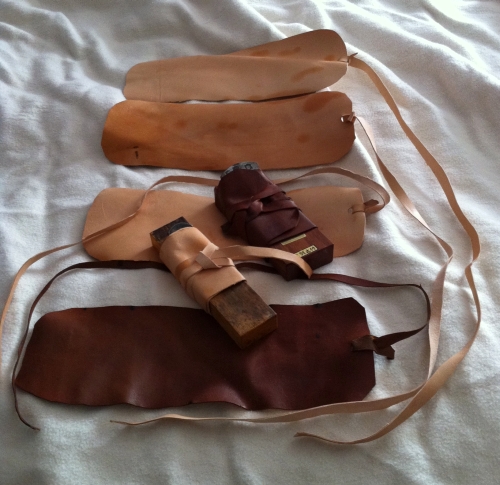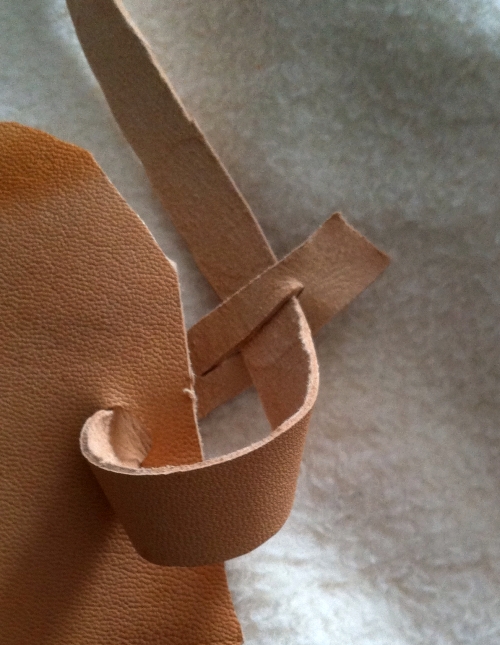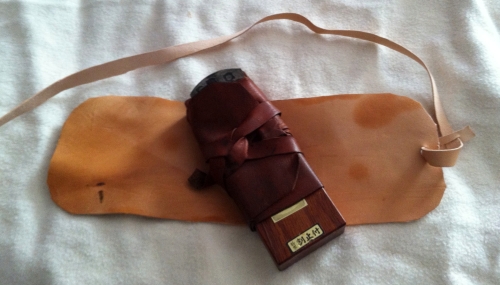I needed a few more plane wrappers. These are a very easy leatherworking project. No need for any fancy embellishments like straight lines. These can be rough.
I had two, the dark ones, and I needed three more. Just in case, I made four.
These wrap around the throat of a plane. The point here is to slow down seasonal chance so the exposed end grain does not split. A bit of preservation on the blade and padding in the tool box are just added benefits.
Here is a simple truth about seasonal change, everyone complains about how dry it gets where they live and how moist it gets and how quickly it can change. If you have snow, it can get damp, dry and damp in short order. If you don’t have snow then it probably gets hot where you are, and so it gets damp dry and damp in short order with hot days and cooler nights. Unless you are in a desert or quite close to the coast, fast seasonal change happens. So a tool wrap makes good sense, just about everywhere!
These are pretty simple, vegetable tan leather first off. Then as one of my foolish and probably suicidal tests, I taste the leather. If it is too salty, then it ain’t right for the job. The leather shown is kind of bitter, rather unpleasant tasting, but not at all salty. The cord is about 28″ long. You want it to wrap around the plane at least twice, so it can hold the leather down, top and bottom. Then you need enough extra to secure it and to start the wrapping out so the cord is holding the cord as much as the joint is.
Where it joins, the tie passes through a hole in the wrap and then through a slit in the tie.
The wrap itself is about 4 1/2″ by 13″. Long enough to go around the width of the plane at least 1 1/2 times so it secures and seals. Wide enough to cover the throat securely with a bit of spare.
After it is shaped, it should be oil cured. Camellia Oil would be classic to use, real olive oil would be fine. I use Ballistol. In this case oil curing is where you rub in enough oil to make the cover barely oily to the touch. This will darken it considerably.
A note on Olive Oil. Olive oil is amazingly resistant to rancidity. If you have a brand of olive oil that goes rancid in less than a couple of years, then my bet would be that you have been sold something else. This is quite typical. You can pay a lot for olive oil that may taste good, but is not pure. This has been going on for a very long time. The old industrial books on soap manufacturing advise you to do a saponification test before purchase and before use to be sure it is the right stuff.
So far the olive oil, that I have gotten under the World Food Market name, has been the real deal. Tastes great, and does not go stale, even after three years, with a bottle that has been opened, half used left outside in Texas and forgotten. That is the sort of quality you need, if you are going to protect wood leather and steel from time and humidity.
Ballistol is the stuff I really like for treating leather that is protecting steel. Time after time, the only rust preventative treatments that work better than ballistol are outright dangerous to touch. Ballistol can be rough on fascists who drink it and insects, but it is fairly safe for most people to handle. The initial smell can be a bit rough.
One more oil to consider, Cod Liver oil is superb stuff and very good for leather. It is used in several formulations to protect car chassis from rust.
Bob




 A page Dedicated to My Writing
A page Dedicated to My Writing
Recent Comments